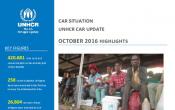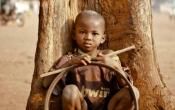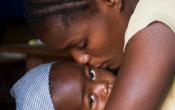Central African Republic
Operation: Central African Republic
Location
{"longitude":20,"latitude":7,"zoom_level":0}
Latest update of camps and office locations 21 Nov 2016. By clicking on the icons on the map, additional information is displayed.
Key Figures
| 2017 planning figures | |
| 300,000 | people will be reached through community sensitization campaigns |
| 30,000 | returnees will receive shelter support |
| 50 | decisions of administrative or judicial bodies leading to re-appropriation of land, housing or property or documentation to people of concern |
| 2015 end-year results | |
| 125,300 | IDPs were reached through community mobilization projects (peaceful coexistence) |
| 60% | of IDP households with needs for basic and domestic items were assisted |
| 95% | of school-aged refugee children were enrolled in primary education in rural areas |
Latest Updates and Related Links
People of Concern
52%
Decrease in
2015
2015
| 2015 | 503,964 |
| 2014 | 1,057,544 |
| 2013 | 911,380 |

[["Refugees",7330],["Asylum-seekers",334],["IDPs",216392],["Returned IDPs",258276],["Returned refugees",21632]]
Loading ...
Budgets and Expenditure for Central African Republic
< Back
2015
{"categories":[2012,2013,2014,2015,2016,2017],"budget":[27.87777777,26.61966467,72.99517142,51.41588869,57.55870367,49.957448046],"expenditure":[10.32988568,11.6062205,30.83826436,28.05206276,null,null]}
{"categories":[2012,2013,2014,2015,2016,2017],"p1":[16.34370845,9.90859819,22.2141765,11.20435682,13.82874993,21.165254301],"p2":[0.82562406,5.51967978,null,null,null,null],"p3":[null,5.07016298,null,null,18.01743734,15.514817844],"p4":[10.70844526,6.12122372,50.78099492,40.21153187,25.7125164,13.277375901]}
{"categories":[2012,2013,2014,2015,2016,2017],"p1":[6.33763752,6.64581075,10.9546183,9.49333057,null,null],"p2":[0.09,0.0895701,null,null,null,null],"p3":[null,null,null,null,null,null],"p4":[3.90224816,4.87083965,19.88364606,18.55873219,null,null]}
Loading ...
CHOOSE A YEAR
- 2014
- 2015
- 2016
- 2017
Working environment
The ongoing crisis in the Central African Republic (CAR) generated up to one million internally displaced people (IDPs) at the height of the crisis in 2014 and some 472,000 refugees in neighbouring countries Cameroon, Chad, the Republic of the Congo and the Democratic Republic of the Congo (DRC). In December 2013, the situation was declared a system-wide, level 3 emergency. With a gradual improvement in the security situation and the deployment of UN forces which allowed the presidential and legislative elections to take place, the number of internally displaced people reduced to about 400,000 by the beginning of 2016. The country equally hosts about 12,000 refugees mainly from Sudan, South Sudan and DRC.Despite the volatile security situation in CAR with outbreaks of violence occurring on a regular basis causing new displacements, returns of IDPs, and to a lesser extent, refugees, have been observed. Returns are expected to continue in stabilized areas within CAR and while UNHCR expects to see an overall reduction of insecurity in 2017, the situation will likely remain fragile with localized conflict continuing in certain areas of the country. New displacement is expected within CAR and to asylum countries linked to possible insecurity caused by the opposition of armed groups to re-establishment of state authority and deployment of the Central African Armed Forces (FACA) in certain parts of the country. The main factors preventing return will be insecurity, lack of social cohesion and conflict related to occupied property.
Key priorities
In 2017, UNHCR’s operation will focus on:• Elaborating a tripartite agreement to serve as a normative framework for the return of CAR refugees;
• Return and reintegration support to returning IDPs and refugees including support to local communities;
• Protection monitoring in areas of return and displacement sites with particular focus on sexual and gender-based violence (SGBV);
• Support to community-based protection and support mechanisms in areas of return;
• Promotion of peaceful coexistence and ensure adherence to the “do-no harm” principle.





